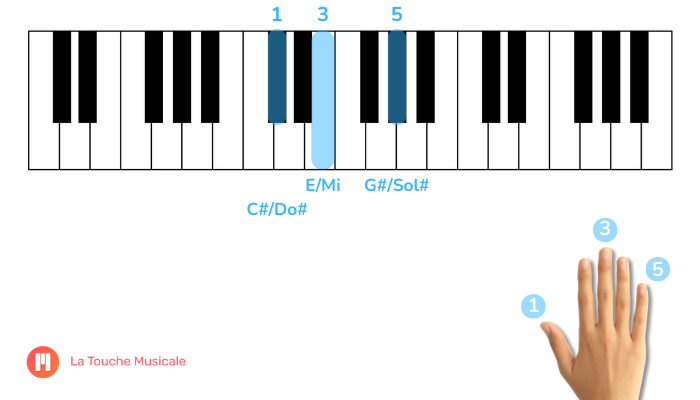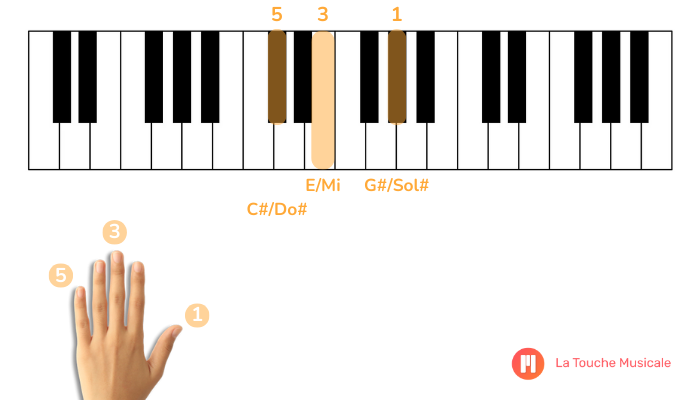
The C# minor chord, noted C#m in Anglo-Saxon notation, occupies a singular place in the musical universe. It stands out not only for its nostalgic, emotive sound, but also for its ability to create intense, memorable atmospheres in a wide variety of musical pieces. This chord, rich in nuance and history, lies at the crossroads between technical complexity and pure emotional expression. In this article, we’ll learn how to compose the C# minor chord, exploring its components, inversions and use across different musical genres.
Learn chords and more with the La Touche Musicale app
The C# minor chord is a musical chord made up of three main notes which, when played together, create a characteristic minor sound, often reflecting darker or more melancholy emotions than major chords. The composition of this chord is based on the C# minor scale.
The use of the C# minor chord is common in many musical genres, from classical music to rock, jazz and pop, offering composers and performers a wide variety of emotional expressions through their works.
G♯ – Fifth finger (5)
E – Third finger (3)
C♯ – First finger (1)


G♯ – First finger (1)
E – Third finger (3)
C♯ – Fifth finger (5)


Learn chords and more with the La Touche Musicale app
C♯ – Fifth finger (5)
G♯ – Second finger (2)
E – First finger (1)


C♯ – First finger (1)
G♯ – Third finger (3)
E – Fifth finger (5)


E – Fifth finger (5)
C♯ – Third finger (3)
G♯ – First finger (1)


E – First finger (1)
C♯ – Third finger (3)
G♯ – Fifth finger (5)


Learn chords and more with the La Touche Musicale app
To master the C# minor chord (C#m) on the piano, it’s important to start with simple exercises to familiarize yourself with the position of the fingers, then gradually integrate more complex exercises to improve fluidity and transition between chords. You can also use our La Touche Musicale piano learning app, which will wait for you to play the right notes before moving on to the next notes in the chord. Here are some exercises you can try:
By practicing these exercises regularly, you’ll develop a solid mastery of the C# minor chord on the piano, enriching your playing and enabling you to explore a wider variety of musical pieces.
This iconic Sting track uses the C# minor chord to create a melancholy, introspective mood. The chord progression and captivating melody perfectly illustrate the expressive use of this minor chord.
Hotel California features a complex chord progression that includes the use of C#m, contributing to the song’s mysterious and somewhat dark atmosphere. Although the C# minor chord is not the main one in the song, its use enriches the harmonic texture of this rock classic.
This poignant track uses the C#m chord to create a melancholy mood that captivates the audience, reflecting the theme of loss and grief that Clapton expresses through the lyrics. The chord progression and gentle melody of Tears in Heaven demonstrate the effectiveness of the C# minor chord in deeply affecting the listener.
At the end of this article, you now have the keys to mastering the C# minor chord and its inversions on the piano. You’re now equipped to enrich your interpretations of popular songs, or to explore new musicalities in your own compositions. The emotional depth of the C#m chord offers a world of creative possibilities, opening the door to rich, nuanced musical expression. Happy musical exploration with C# minor!
It’s a triad made up of a root note, a third and a fifth.
G♯ – Fifth finger (5)
E – Third finger (3)
C♯ – First finger (1)
C♯ – Fifth finger (5)
G♯ – Second finger (2)
E – First finger (1)
E – Fifth finger (5)
C♯ – Third finger (3)
G♯ – First finger (1)
La Touche Musicale is a popular app specialized in piano learning. You can register for free and learn to play your favorite songs with this chord and many others.
You can use our La Touche Musicale app or browse our blog category to learn how to play all the popular piano chords.
Help democratize piano learning by sharing this article:
Learn to play all the chords to your favorite songs on the piano




Legal